The old location of Lower Paiwan Village is now called kapaiwanan (meaning the original Paiwan land), which stands not far from the current Lower Paiwan police station and still preserved are the old homes of Taugadu, Mavaliu and other chiefs and Houses.In legends concerning the origin of Paiwan, most point to Padain as the source, however the residents here all deny it.The villagers said,“We begin here.In the beginning the sun and the moon both gave birth to an egg, which became a man and a woman after hatching,called Saljimlji and Savatjuljayan.Savatjuljayan sang and produced the tribesmen to form the Paiwan Tribe of today, while Saljimlji was not only adept at farming, hunting, weaving and wizardry but as he also knew about everything he passed his methods to the tribesmen, thus Paiwan Tribe developed and then branched out.”They also said,“The god who sang and created in Padain did not come to this village.”Some also claimed, “At Kinivavucan stands two great trees called the forbidden trees which people fear to go near.Under the trees there is a vase of one foot 5 inches in diameter and two feet tall, where the eggs of the sun and moon are hidden.”According to Chief Hsiou of Qapulu House,“In the five-year festival of Paiwan Tribe only ceremonies for entering and not for welcoming are held, since the ancestral spirits reside here and it is where the tribe started.”However the enormous forestry in the area have been ruthlessly cut down, with none being spared, and the roads that pass through the old sites have led to destruction of many structures left behind by ancestors.Although in the recent years deforestation has stopped and new trees have grown, the damaged old sites can never be stored.
Researched and recorded by: Hsiao-ning, Hsiao-rong, Hsiao-rou
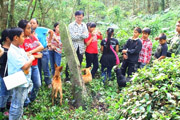 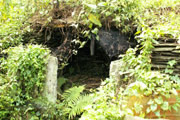
◎ Investigating the Old Village:
Entering the Forbidden Land (09/12/2006)
Records:Hsiao-rong
It is early morning, and while ignoring the rumbles of my starving stomach Chief Ching led us around the village to show us the Chief’s homes, the descendents of She-jih and the descendents of Ding-tien.Hey!Aren’t they mythical characters? How does he know who to point out and where they live? That’s really extraordinary!We also saw the rice fields at dawn, a field of green.The sprinkler made“Pu Tsi! Pu Tsi!”sounds as it turned.We also saw the remnants of the sacred hall of the village.Chief Ching is really a treasure of the village, since at 78 years of age his memories are fantastic, and although his mandarin is not that good he is so eager to teach uswhat he knows.We’ve got to work harder!
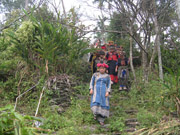 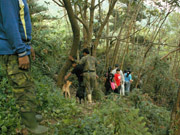
After we fed our stomachs we headed out to Kapaiwan, the founding grounds of Paiwan Village, under stern warning by Uncle A-de:“No shouting, no knocking on stone slabs, no littering and no one leaves the group!”This time Grandpa Hsu was the guide.Grandpa Hsu was once the people’s representative of Majia Township and is currently 77 years of age.He stays in the mountains to herd sheep.I thought we were to travel on the old roads, but they were blocked by weeds and are impassable, so we took the hunter’s trail, not knowing that it was to be the start of a startling trip.
We followed the road to the cliff edge,thinking that we would rest there,when suddenly Grandpa Hsu started downwards along the Cliffside.I got cold feet when I reached the edge, but after watching the teacher move forward, followed by students in a row,I gathered my courage and also headed down.What followed were our screams while the teacher yelled, “Step here and grab the branches!”Warning shouts sounded from everywhere but most of the time my bums was gliding along the ground.After close to 40 meters it became somewhat easier to walk, and after a further 10 minutes the collapsed slab houses began to appear.Uncle A-de called this place Tuljangav (a small old village),and when he was younger (1965) an elderly man lived here.Further on and many slab houses started to appear – this is one of the founding grounds of Paiwan Tribe – Kapaiwan.We followed what Uncle A-de’s had said earlier and listened closely to Grandpa Hsu’s explanations of the owners of various houses.We also saw the tribe’s spiritual beacon, a slanted stone pillar where knocking was forbidden.The trip would have continued but due to time and our stamina only the directions to the remaining places of interest were shown.It seems that if you carry on downwards you will find a big tree marking the gate to hell, a place spoken about in legends.Strange!Places from legends seem to be all around us.While we headed back the teachers went to the lookout area,it is located on the cliff edge and was a good area to spot surprise attacks from Houcha and Ma-er tribes.Of course, the way back was very tiring and finally we reached the roads.It felt like a breathless trip to hell.
 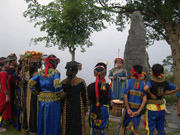
At the road everyone was covered in sweat and we were exhausted,so we rested a bit before the teacher took us to Grandpa Hsu’s house for a visit.Grandpa Hsu’s house is a slab house from before the Japanese Occupation period.It is the most traditional and thus also very simple.After entering you see the kitchen with the bedroom next to it.Outside are stone tables and chairs which felt so pleasant to sit on.Grandpa Hsu also told us that he belongs to the Qapulu House.Grandpa Ching belongs to Daugudu House,he knew where the aborigines would buried their families and showed where his grandfather was buried, but obviously we only saw the stone floor,else we would have gotten a fright.He also told us where the tribe gathered stones and the location of the big footprint.
What a fulfilling visit! It has only been 24 hours since yesterday afternoon, but thinking back,there are really so many memories for us to keep in our hearts and pass on.Our question was when can we come back?It was truly so much fun.But the teachers would not answer us, maybe they are tired.We can only hope to see it again!
Top |
